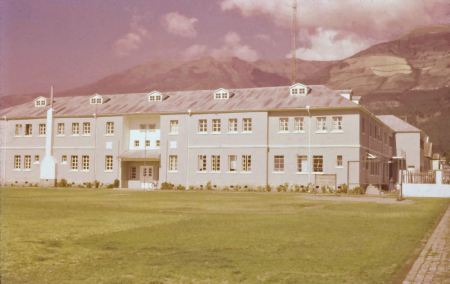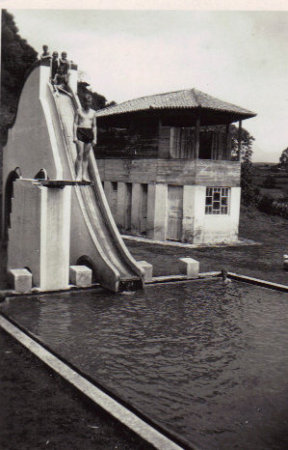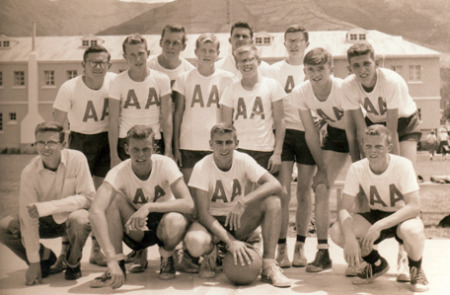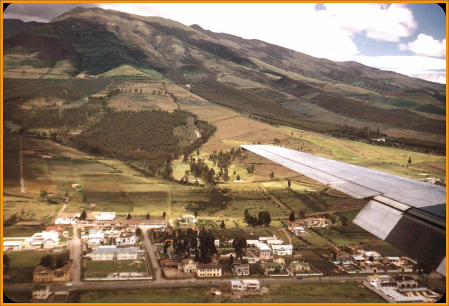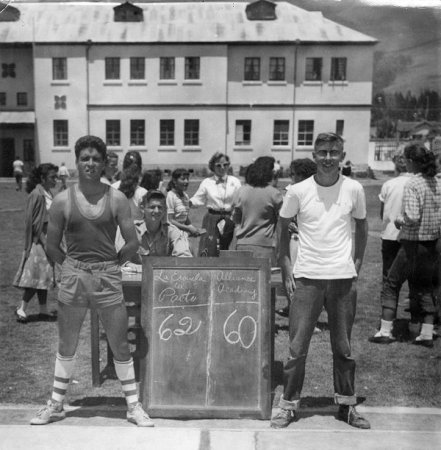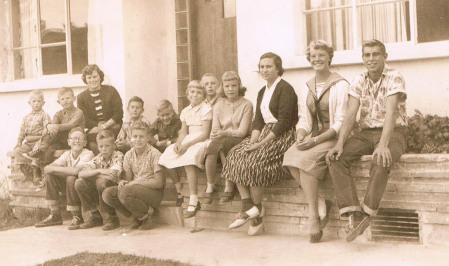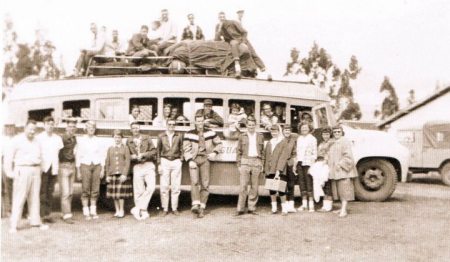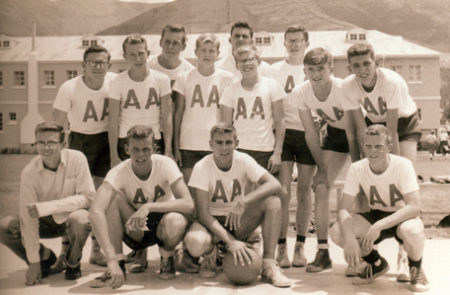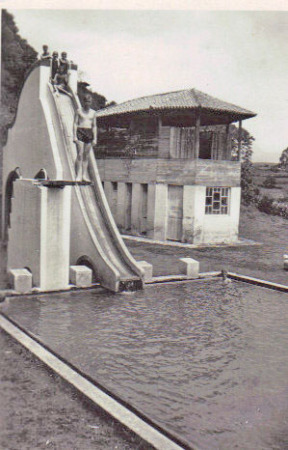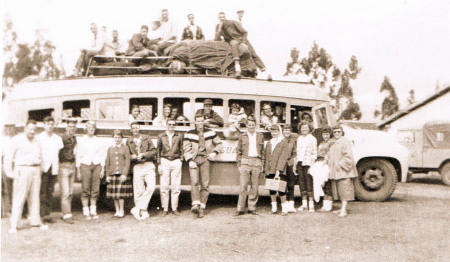Jim Flory:
CLASS OF 1960
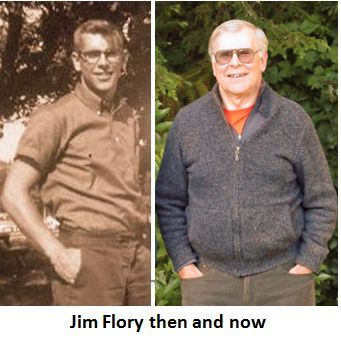
Alliance AcademyClass of 1960
Quito,
Jim's Story
Dear AA Alumni and Friends,
Since my retirement I have really enjoyed getting in contact with friends and alumni from the AA. I tried to put up a shorted illustrated biography from my website but this system apparently doesn't permit external links so here is more than will ever want to know that I could quickly cut an paste in here.
Timeline Since Alliance Academy ÃÂ Jim Flory
1960 - 1963 - Manchester College - Small Church of the Brethren liberal arts college. Wonderfully stimulating intellectual and cultural atmosphere for me but also difficult time of adjustment. Good friends with 8 roommates who shared a house.
1963 - 1966 - Purdue University - MS Physical Education, Spanish, Psych
Pursued physical education by default and the strong belief that it provided a wonderful developmental tool in the education of children. The world of sports is a wonderderful simple social system which is also a time out from the real world. One where making mistakes while not pain free, is less so than in the real world because we can always say, "it was only a game". Not only physical but also social, since in reality it is a simple social system which can serve as a lab for social learning. Most physical educators didn't see it that way, but I found great pleasure in the joy of students in my classes as they learned new skills both physical, social, and insights into social structure. In a carefully controlled environment you can set things up in a way that insights come from the experience. For example, on the playground only the best athletes are captains. I could put less skilled kids in the position of choosing teams. The first time they would choose teams based on friendships. This usually led to losing the game. Next time they would chose based on a combination friendship and sports competence. I delighted in creating "natural experiments" where encouraging kids to reflect on what we had just been through together. I also found analyzing sports skills (kinesiology) fun especially given the variety of skills involved in gymnastics. The danger of injury makes the figuring out safe lead up progressions and also it is interesting in that you need to get to know each athlete well enough to make judgments not only about physical readiness but also psychological readiness for trying potentially dangerous moves.
1966 - 1968 - Taught physical education, Spanish, and coached track and field at Taft Junior High School, Crown Point, Indiana. This was part of my plan to gain experience teaching young students and building a winning coaching record. My next planned step was to move to high school coaching and do the same. Actually I had a high school offer when I left. Then I was going to return get a PHD in Physical Education or Sociology and write the definitive work on the cultural, sociological, and social psychology of sports. My ultimate goal was going to be college teaching and international sports clinics.
1968 Influenced by the death of Martin Luther King Jr. (and other events in the late 1960's) and my experience of the of the American school system; I enrolled in a graduate program in sociology at Indiana University. It seemed to me that in many respects the school system by its very nature was teaching things I didn't want to teach and turning me into somebody I didn't want to be. I wanted to understand social structures with the ultimate goal of changing them.
Summers - Camp Counselor at a great camp in Wisconsin, and two work camps in Mexico which were really fun and interesting.
1968 - 70
After feeling like a prison guard at the junior high school, the freedom of graduate school was a period of mild euphoria. I had burned no bridges behind me, so that I could return to physical education if grad school didn't work out (gymnastics coaches were in high demand in Indiana at that time), this took a lot of pressure off of me that others in grad school felt. I had a wonderful time playing club volleyball for Indiana University (clubs were not a varsity sport with full funding and scholarships) but supported to the extent of a coach and travel/meal funds for tournaments. We practiced 2 hrs a day 5 days a week and traveled to tournaments around the Midwest what fun! This started me on a career of USVBA volleyball which I continued until 1994. I had no background in sociology beyond an introduction to sociology class and a social problems class taken in 1962. These classes had convinced me that the social sciences were a waste of time. So I had to work hard to catch up. I didn't understand how the academic game was played at Indiana University until it was too late, so I ended up with an MA and a fair amount of the course work for a PHD done as well. At IU I met Eileen who was also a graduate student who had spent time in Mexico doing ethnomusicology and anthropology in village Mexico. She and I also were active in the local silent meeting type Quaker student group there.
1970 - 1986 Taught sociology at Inver Hills Community College, Inver Grove Hts. Minnesota.
Eileen's PHD program fell apart in 1971 when her professor died. She had the music from an all night curing ceremony from Otomi Indians in Mexico. Previous work with these Indians suggested that musical themes carried semantic content for the Otomi. She was in the process of learning a computer program (main frame days) which searched for patterns. She planned to transcribe the music, code it for the computer, search for patterns, take the patterns back to the field to play segments and ask what they meant. You can see how it would be hard to find a graduate advisor to take over this project. So she decided to abandon that plan and came up to Minnesota and we got married.
In many ways teaching sociology to a largely working class, multi aged, student body was a good fit for me. It let me pursue almost any topic and then work to translate it into terms and concepts my students could understand. I taught four courses - Intro to Sociology, Analysis of American Society, Social Problems, and Marriage and Family. Pay and benefits were good: three months off in the summer, plus long winter break, a brand new campus, and with many young friendly and competent faculty.
I arranged my teaching schedule so I could play good quality volley ball three times a week and continued to play with USVBA teams. I had time and the opportunity for outdoors activities, many of which I shared with my wife. Such things as cross country skiing, winter camping, snow shoeing, backpacking, mountaineering, and canoeing.
1979 - Sabbatical year - I took courses at the U. of Minnesota. I also traveled with my wife to Cuba on a two week study tour and later in 1982 enrolled in a longer study opportunity in a Cuban educational institution. I also went out to Wyoming on a month long National Outdoor Leadership school course on mountaineering in the Wind River range. The first of three courses I took with them over the years.
1985Â I took a year's leave of absence in which I took courses at the University of Minnesota to try to figure out how to make teaching interesting again. I also took some computer courses from the education department there.
I worked hard at the community college job but eventually burned out and lost my belief that the work was very useful. Teaching under the constraints of class size (sometimes very large and the nature of the student population, etc.) made teaching more of a performance art than I had expected and e...Expand for more
ven Broadway shows don't have a 15 year run.
1986 Resigned from the community college. I found it hard to find a suitable work. Fortunately Eileen and I lived simply, had paid off our house, car, etc. Eileen by this time had a great job at the Science Museum of Minnesota working in a wide range of positions for them. Everything from the anthropology floor exhibit planning to, director of education, and with the added benefit of being sent to Antarctica, a two week rafting trip in the Grand Canyon, extended collection trip to Chiapas Mexico, two week river trip on the Amazon out of Iquitos, a solar eclipse in Baja California, - you get the picture.
Anyway, as I cast around for work I had a lot of time to be engaged in social change movements and volunteer work for good causes. Probably the most important work centered on refugees from the wars in El Salvador and Guatemala. I did volunteer political asylum translations, was very involved in the Sanctuary movement, and as the result of accompanying an extended family out of El Salvador ended up being a volunteer social worker for the extended family of 13 people over a period of about 2 years. I helped the family with everything from jobs, welfare, medical crisis, alcoholism, English classed, etc.
I also was able to help write a report for the Northern Cheyenne on Amax Coal Company to help equalize the playing field as the tribe negotiated with the company for possible coal development on the reservation.
Though this period of unemployment troubled me at the time, it turned out fine in the end and I think of it as the most socially useful work period in my life.
1988 - I got a very interesting job as a software developer for a computer based pilot training program. Airliners at about this time were undergoing a substantial change in the cockpits with the introduction of computerized cockpit management systems. These were known in the industry as "glass cockpits". This meant the generation of world war two bomber pilots had to learn to live with computers, which they were reluctant to do. I wrote "Programmer Ready Material" lessons for various cockpit control systems for a very good quality graphics based package.
This was a large project in which I played my small part. It involved a team of probably 40 people, maybe more. As developer, it was my job to read the Boeing and United manuals for the specific system the lesson was to cover. Then I outlined the content in a relatively uniform lesson style, met with a United Airline pilot trainer (subject matter expert) for direction, corrections, and suggestions (including the dynamic schematic diagram and graphics needed). Then I wrote detailed graphics programming instructions for each change in the schematic, and planed a sequence of instruction that would involve a minimum amount of resetting of the schematic diagram screens, while writing the lesson content within the standard language and editorial guidelines. We also developed tests that would evaluate the students progress and preferably that would be answered by action (making the correct cockpit instrument changes on the touch screen) and provide feed back whenever the student made errors.
We did complete programs for the 747, 737, and 757/767. The last two airplanes were built so that a pilot trained to fly a 757 would be able to fly a 767 as well, since there were minimal differences between the two. So it made sense to me as I listened to the 9/11 news and heard that all the planes flown by the hijackers were either 757s or 767s.
Anyway eventually we did finish the project and the programs were popular and expensive. Airlines all over the world were buying them, customized with their own logos, etc. When companies are buying ten 747's at the then price of around 180 million dollars each nobody even notices a few million dollars for computer based training software.
After the company made enough sales on this project the division of Control Data was sold to someone else and they bought a whole lot of other Control Data education products designed for mainframes. I was hired back first as a consultant then as employee to use the same content (very good) but to make them adaptable to PCs, graphics rich, culturally inclusive, with adult applications and examples. So we developed lessons for adult basic education in math, English, etc . I worked on the math lessons  we did a complete; curriculum remedial math through high school algebra, geometry etc. The market was to be prisons, the army, corporate training, learning labs, etc. It was more socially useful perhaps but not as interesting to me as the airline content.
1994 -
My wife Eileen, who grew up in Eugene, Oregon was tired of Minnesota winters (23) and wanted to go home to Oregon. So when her dream job opened up on the Oregon Coast at a small, but high quality Aquarium located in Newport Oregon, we moved here to make her dreams come true. Another large factor was to be close to her mother whose health was failing. The move proved to be a good one on both counts.
I got part time work at the very small local community college, teaching sociology and doubled the number of classes I could offer by developing high quality online sociology courses for distance ed students; thus increasing my market area to the State of Oregon as well as some out of state students. The online classes were very popular and usually filled early. I retired in 2006.
2006 - Unfortunately Eileen'Âs job at the Aquarium came to an end when the President of the Aquarium was convicted of fraud leading to a financial crisis for the aquarium. The president had secretly forged loan papers which no-one, including the board, knew about. The resulting financial crisis led to layoffs and my wife did other short term contracting work and taught partime in the local community college's aquarium science program until she retired. This was a change of plans since she is 5 years younger than I am and we had planned on her income and benefits for another 5 years.
Currently I have found myself dealing with health concerns as my body is now out of warranty. I narrowly missed having back surgery by being willing to put up with a year of recovery (three herniated discs, one vertebra slipped out of alignment and scoliosis) with the aid of poppy plant derivatives. Nevertheless, I'm back to long hikes again, paddling my kayak, and ping pong. The last years have improved my ping pong immensely; I have been playing with some really serious table tennis players and it has been great fun to be getting better at something at my age.
I read a lot, present a couple of presentations a year to the Oregon Coast Learning Institute. They are two hour presentations to a great audience of retired folks with active interests. I have done presentations on Cuba (before and after the collapse of the USSR), the American Class System (there is a bimodal curve in terms of the audience - retired teachers at low end and retired wealthly folks on the other). I also did a presentation on mountaineering which has been one of my passions and my favorite spiritual practice. These presentations give my reading a focus and purpose.
Religion took with me as a child but has metamorphosed as the years have passed. I call myself a socially engaged, postmodern, universalist contemplative. I have been active in several local Friends Meetings and been on committes of regional Quaker organizations.
Register for Free to view all details!
Reunions
Register for Free to start a reunion event!
Photos
